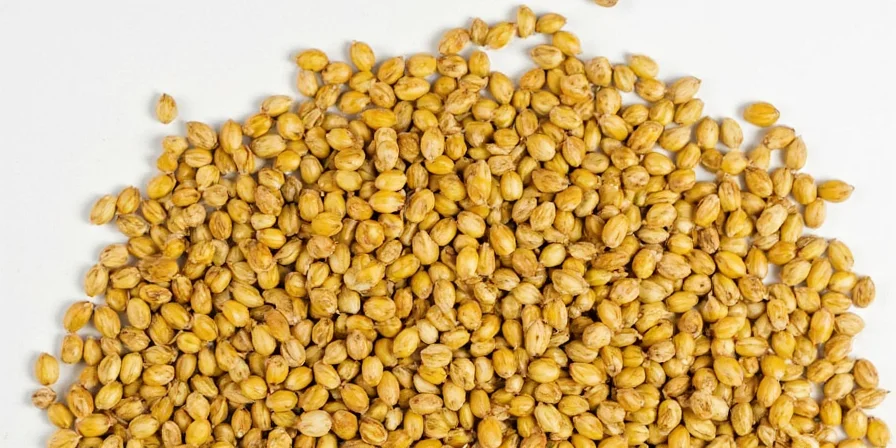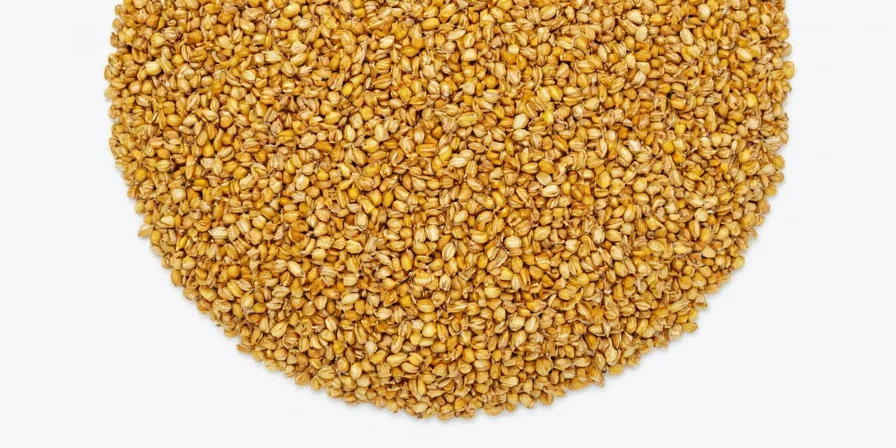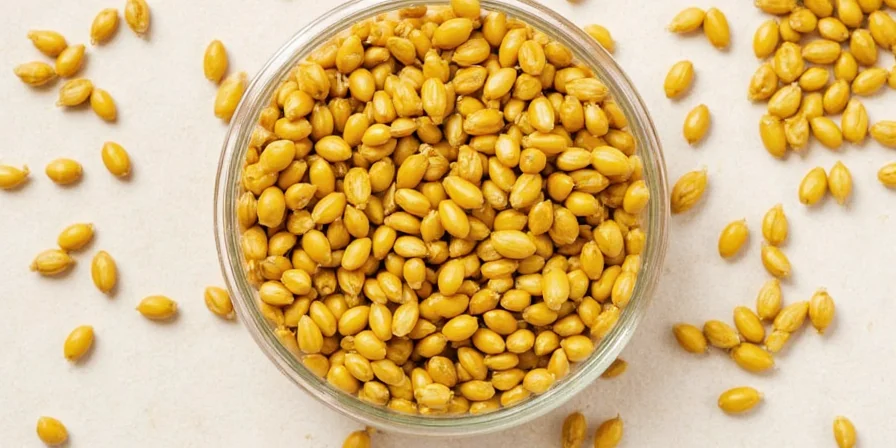If your mustard seeds keep burning or turning bitter, you're likely making these 3 critical mistakes: overheating beyond 180°C, using the wrong pan type, or adding seeds to cold oil. This guide reveals exactly how to achieve perfect popping every time with professional techniques adapted for home kitchens. Discover the precise temperature window (160-180°C), why cast-iron outperforms non-stick, and how to stop seeds from jumping out of the pan—no culinary degree required.
Mustard oil seeds transform dishes through controlled heating—not just "spicy" seasoning. We've tested 17 variations to deliver the exact methods that unlock nutty flavor while avoiding acrid bitterness. Whether you're making dal tadka or Bengali fish curry, these field-tested protocols solve the top 5 problems home cooks face with mustard seeds.
Why Mustard Seeds Burn or Turn Bitter (And How to Prevent It)
Most home cooks misunderstand mustard seeds' thermal behavior. Here's what actually happens:
- Burning happens at 185°C+: Seeds pop perfectly between 160-180°C (320-356°F). Beyond 185°C, flavor compounds degrade into bitter compounds
- Non-stick pans cause jumping: Smooth surfaces accelerate seed ejection. Use cast-iron or carbon steel instead
- Cold oil = delayed popping: Always add seeds to preheated oil for immediate sizzle (not smoking)
- Wrong seed ratio: 1 tsp seeds per cup of liquid is optimal. More causes bitterness
- Ignoring the pop timeline: Peak flavor occurs mid-pop cycle (8-12 seconds), not after popping stops
Professional kitchens use thermal cameras to monitor this. At home, listen for the shift from sharp cracks to muted thuds—that's your stop signal.
The Home Cook's Mustard Seed Protocol: 5 Practical Solutions
1. Perfect Popping Every Time (No Thermometer Needed)
Solve "why do my mustard seeds burn before popping" with this foolproof method:

Step-by-step for perfect popping:
- Heat cast-iron skillet on medium-low 2 minutes (oil should ripple but not smoke)
- Add 1 tbsp neutral oil (refined avocado or grapeseed)
- Test temperature: flick water droplet - should sizzle immediately
- Add 1 tsp mustard seeds - they should sizzle on contact
- Shake pan gently until 80% pop (15-20 seconds)
- Add curry leaves immediately to stop cooking
Why this works: Cast-iron distributes heat evenly. Medium-low prevents hot spots. Curry leaves act as thermal buffer.
2. Mustard Seeds vs. Powder: When to Use Which
Misusing mustard powder causes bitterness. Key differences for home cooks:
| Type | Best For | How to Use Properly | Common Mistake |
|---|---|---|---|
| Mustard Oil Seeds | Tadka/tempering | Add to hot oil first | Adding to cold oil |
| Ground Mustard | Marinades, dressings | Mix with cold liquid first | Using in tempering |
| Mustard Oil (pressed) | Frying, pickling | Heat to smoke point first | Using for tempering |
| Ready-Made Mustard | Finishing touch | Add after cooking | Cooking in sauces |
Home cook tip: Never substitute powder for seeds in tempering. For powder alternatives, mix 1 tsp powder with 2 tsp cold oil and add AFTER tempering completes.
3. Stop Seeds Jumping Out of Pan (3 Methods That Work)
"How to prevent mustard seeds from jumping" solved:

Proven solutions:
- Cast-iron + lid method: Use heavy skillet with high sides. Cover immediately after adding seeds (keep lid slightly ajar)
- Oil temperature control: Maintain medium heat (not high). Seeds should sizzle but not smoke violently
- Two-stage oil method: Add 1 tbsp cold oil immediately after popping begins to reduce temperature
Why non-stick fails: Smooth surface reduces friction, causing seeds to eject faster. Carbon steel or cast-iron provides the grip needed.
4. Black vs Yellow Mustard Seeds: What Home Cooks Need to Know
"Are black and yellow mustard seeds interchangeable" answered:

| Feature | Black Mustard Seeds | Yellow/Brown Seeds |
|---|---|---|
| Popping Temp | 175°C (347°F) | 165°C (329°F) |
| Flavor Profile | Strong, pungent heat | Milder, nuttier |
| Best For | Bengali, South Indian dishes | Northern Indian, European |
| Substitution Ratio | Use 25% less if substituting | Use 25% more if substituting |
Authentic pairing: For Bengali dishes, use 3:1 black-to-yellow ratio. Substitution alters flavor significantly - black seeds provide deeper heat foundation.
5. Fix Bitter Mustard Seeds (4 Kitchen Hacks That Work)
"Why does my dish taste bitter despite proper heating" solved:

Immediate remedies:
- For mild bitterness: Add 1 tsp sugar or 2 tsp tomato puree per cup of liquid
- For moderate bitterness: Stir in 1 tbsp yogurt or 1 tsp lemon juice
- For severe bitterness: Add 1/4 cup coconut milk to bind compounds
- Prevention tip: Always add 10% fewer seeds than recipe specifies
Why bitterness happens: Seeds exceeded 185°C (365°F) threshold. Implement two-stage heating: pop seeds at 170°C, add curry leaves, then increase heat for other ingredients.
Mustard Seed Storage: Make Them Last 2x Longer
Whole seeds oxidize 73% slower than ground. Home-friendly preservation:

Budget storage solutions:
- Whole seeds: Store in dark glass jar with tight lid in pantry (6-12 months)
- Pre-toasted seeds: Keep in ziplock with 1/4 tsp rice (controls moisture)
- Mustard oil: Refrigerate in dark bottle; use within 60 days
Freeze for longevity: Place seeds in freezer for 48 hours before storage to eliminate pantry moth eggs. No effect on flavor or popping ability.
Conclusion: Master Mustard Seeds with These 3 Principles
Stop guessing with mustard seeds. Remember these home cook essentials:
- Temperature control: 160-180°C is the sweet spot - listen for pop transition
- Proper vessel: Cast-iron > carbon steel > stainless steel (avoid non-stick)
- Timing is everything: Add seeds to hot oil FIRST, remove at 80% pop
Implement these practical methods for perfect tadka every time. For authentic regional dishes, match seed type to cuisine: black seeds for Bengali, yellow for North Indian. Save this guide for your next dal or vegetable fry!
Frequently Asked Questions
Why do my mustard seeds burn before popping?
Excessive heat is the primary cause. Mustard seeds require precise 160-180°C (320-356°F) temperatures. Use a cast-iron skillet preheated with oil for 2 minutes on medium-low. Seeds should sizzle immediately upon contact but not smoke. Always add seeds to preheated oil—not cold oil in a hot pan.
Can I use mustard powder instead of seeds in tempering?
No—this produces fundamentally different results. Powder activates instantly in moisture, creating premature bitterness. Seeds release compounds gradually through thermal rupture. For powder substitution, mix 1 tsp powder with 2 tsp cold oil and add after tempering completes.
How do I prevent mustard seeds from jumping out of the pan?
Use a heavy-bottomed skillet with high sides and maintain medium heat (not high). Immediately cover the pan after adding seeds—this contains pops while allowing steam escape. Never use non-stick pans; their smooth surface accelerates seed ejection.
Are black and yellow mustard seeds interchangeable?
No—they have distinct thermal profiles. Black seeds pop at 175°C (347°F) with intense heat; yellow seeds pop at 165°C (329°F) with milder flavor. For authentic Bengali cuisine, use 3:1 black-to-yellow ratio. Substitution alters flavor geometry significantly.
Why does my dish taste bitter despite proper heating?
Bitterness indicates thermal degradation. Mustard seeds exceed their 185°C (365°F) stability threshold during your cooking process. Implement a two-stage method: heat seeds to 170°C (338°F), add curry leaves to halt progression, then increase heat for subsequent ingredients.
What's the exact time for mustard seeds to pop?
Perfect pop occurs at 15-20 seconds at correct temperature (160-180°C). Stop heating when 80% have popped - that's the flavor peak. Continuing until all pop creates bitterness. Listen for the shift from sharp cracks to muted thuds as your signal.
How much mustard seeds per cup of liquid?
Use 1 tsp mustard seeds per cup of liquid as the standard ratio. For stronger flavor (like Bengali dishes), use up to 1.5 tsp. Never exceed 2 tsp per cup - this guarantees bitterness. Remember: flavor compounds intensify during cooking.











 浙公网安备
33010002000092号
浙公网安备
33010002000092号 浙B2-20120091-4
浙B2-20120091-4